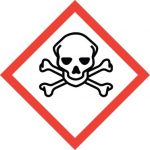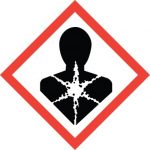Revision Date: 01/24/2023
1. IDENTIFICATION
Name: Uranium Trichloride
Synonyms: Uranium (III) chloride
Article Number: 22500, 22501
CAS Number: [10025-93-1]
Relevant identified uses of the substance or mixture and uses advised against: No further relevant information available.
Application and preparation of the substance: Laboratory chemicals.
Supplier
IBI Labs
3495 N. Dixie Hwy. Unit # 8
Boca Raton, FL 33431
Tel: 561-826-0061 Fax: 561-892-8450
Emergency Telephone Numbers
INFOTRAC
USA & Canada contact number: 1-800-535-5053
International contact number: 1-352-323-3500
2. HAZARDS IDENTIFICATION
Classification of the substance or mixture:
GHS06 Skull and crossbones
H301 Toxic if swallowed.
H331 Toxic if inhaled.
GHS08 Health hazard
H373 May cause damage to organs through prolonged or repeated exposure.
Classification according to Directive 67/548/EEC or Directive 1999/45/EC:
- Very toxic
- Very toxic by inhalation and if swallowed.
- Danger of cumulative effects.
Information concerning hazards for human and environment: Not applicable.
Label Elements
Labeling according to EU guidelines: The product has been classified and marked in accordance with directives on hazardous materials.
Code letter and hazard designation of product: Very toxic.
Risk phrases: Very toxic by inhalation and if swallowed.
Danger of cumulative effects.
Safety phrases:
- Keep away from living quarters.
- Keep container in a well-ventilated place.
- When using do not eat, drink, or smoke.
- Wear suitable protective clothing.
Classification System
NFPA ratings (scale 0 – 4):
4
0
0
Health = 4
Fire = 0
Reactivity = 0
HMIS-ratings (scale 0 – 4):
HEALTH
FIRE
REACTIVITY
4
0
0
Health = 4
Fire = 0
Reactivity = 0
Other Hazards
Results of PBT and vPvB assessment
PBT: Not applicable.
vPvB: Not applicable.
3. COMPOSITION AND INFORMATION ON INGREDIENTS
Chemical Characterization: Substances
CAS No. Description 10025-93-1 Uranium Tri Chloride
4. FIRST AID MEASURES
General information: Immediately remove any clothing soiled by the product.
Remove breathing apparatus only after contaminated clothing have been completely removed.
In case of irregular breathing or respiratory arrest provide artificial respiration.
After inhalation:
- Supply fresh air or oxygen; call for doctor.
- In case of unconsciousness place patient stably inside position for transportation.
After skin contact: Immediately wash with water and soap and rinse thoroughly.
After eye contact: Rinse opened eye for several minutes under running water. Then consult a doctor.
After swallowing: Do not induce vomiting and immediately call for medical help.
Information for Physician
Most important symptoms and effects, both acute and delayed: No further relevant information available.
Indication of any immediate medical attention and special treatment needed: No further relevant information available.
5. FIREFIGHTING MEASURES
- Extinguishing Media
Suitable Extinguishing Agents: CO2, extinguishing powder, or water spray. Fight larger fires with water spray or alcohol resistant foam.
Special hazards Arising From the Substance or Mixture: No further relevant information available.
Protective equipment: Mouth respiratory protective device.
6. ACCIDENTAL RELEASE MEASURES
Environmental Precautions: Do not allow to enter sewers/surface or ground water.
Methods and Material for Containment and Cleaning Up:
- Dispose contaminated material as waste according to item 13.
- Ensure adequate ventilation.
Reference to Other Sections:
- See Section 7 for information on safe handling.
- See Section 8 for information on personal protection equipment.
- See Section 13 for disposal information.
7. HANDLING AND STORAGE
- Handling
Thorough de-dusting, ensure good ventilation and exhaustion at the workplace. Open and handle receptacle with care.
Keep respiratory protective device available to protect against fires.
- Storage
No special requirements to be met by storerooms and receptacles.
There is no required information about storage in one common storage facility.
Keep receptacle tightly sealed.
8. EXPOSURE CONTROLS AND PERSONAL PROTECTION
- Control Parameters
There are no required components with limit values that require monitoring at the workplace.
- Exposure Controls
Personal Protective equipment:
- Immediately remove all soiled and contaminated clothing.
- Wash hands before breaks and at the end of work.
- Store protective clothing separately.
- Keep away from foodstuffs, beverages, and feed.
Breathing equipment:
- In case of brief exposure or low pollution use respiratory filter device.
- In case of intensive or longer exposure use respiratory protective device that is independent of circulating air.
Protection of hands:
- The glove material has to be impermeable and resistant to the product, the substance, and the preparation.
- Due to missing tests no recommendation to the glove material can be given for the product, the substance, and the preparation.
- Selection of the glove material on consideration of the penetration times, rates of diffusion and the degradation.
- The selection of the suitable gloves does not only depend on the material, but also on further marks of quality and varies from manufacturer to manufacturer.
- Regarding the penetration time of glove material, the exact break through time must be found out by the manufacturer of the protective gloves and has to be observed.
Eye protection: Not required.
9. PHYSICAL AND CHEMICAL PROPERTIES
Form: Powder.
Color: Green.
Odor: Acetone-like.
Melting Point: 837°C
Boiling Point: 1657°C
Flammability (solid, gaseous): Product is not flammable.
Density, kg m-3: 5500 kg m-3
Solubility: Water soluble
10. REACTIVITY
- Chemical stability
There isn’t decomposition if used according to specifications.
No dangerous reactions known.
Conditions to Avoid: No further relevant information available.
Incompatible Materials: No further relevant information available.
Hazardous Decomposition Products: No dangerous decomposition products known.
11. TOXICOLOGICAL INFORMATION
Information on Toxicological Effects
- Acute Toxicity
On the Skin: No irritant effect.
On the Eyes: No irritating effect.
Sensitization: No sensitizing effects known.
- Additional Carcinogenic Categories
IARC (International Agency for Research on Cancer): Substance is not listed.
NTP (National Toxicology Program): Substance is not listed.
12. ECOLOGICAL INFORMATION
- Toxicity
Aquatic toxicity: No further relevant information available.
Persistence and biodegradability: No further relevant information available.
- Behavior in Environmental Systems
Bio Accumulative Potential: No further relevant information available.37.0
Mobility in Soil: No further relevant information available.
- Additional Ecological Information
General Notes: Hazardous for water. Do not allow product to reach ground water, water course or sewage system. Danger to drinking water if even small quantities leak into the ground.
Results of PBT and vPvB Assessment
PBT: Not applicable.
vPvB: Not applicable.
Other adverse effects: No further relevant information available.
13. WASTE TREATMENT METHODS
Recommendations: Must not be disposed of together with household garbage. Do not allow product to reach sewage system.
- Uncleaned Packaging
Recommendation: Disposal must be made according to official regulations.
Recommended Cleansing Agent: Water, if necessary, with cleansing agents.
14. TRANSPORTATION
UN-Number: DOT, ADR, IMDG, IATA: UN2910
- UN Proper Shipping Name
DOT: Radioactive material, excepted package-limited quantity of material.
ADR: 2910 Radioactive material, excepted package-limited quantity of material.
IMDG, IATA: Radioactive Material, Excepted Package-Limited Quantity of Material.
- Transport Hazard Classes
DOT, ADR: Class 7 Radioactive Material.
- Environmental Hazards
Marine Pollutant: No.
Special Precautions for User: Warning, radioactive material.
- Transport in Bulk According to Annex II of
MARPOL73/78 and the IBC Code: Not applicable.
UN “Model Regulation”: UN2910, Radioactive material, excepted package-limited quantity of material, 7
15. SAFETY, HEALTH, AND ENVIRONMENTAL REGULATIONS/LEGISLATION SPECIFIC FOR THE SUBSTANCE OR MIXTURE
- Sara
Section 355 (extremely hazardous substances): Substance is not listed.
Section 313 (Specific toxic chemical listings): Substance is not listed.
TSCA (Toxic Substances Control Act): Substance is not listed.
- Proposition 65
Chemicals known to cause cancer: Substance is not listed.
Chemicals known to cause reproductive toxicity for females: Substance is not listed.
Chemicals known to cause reproductive toxicity for males: Substance is not listed.
Chemicals known to cause developmental toxicity: Substance is not listed.
- Carcinogenic Categories
EPA (Environmental Protection Agency): Substance is not listed.
TLV (Threshold Limit Value established by ACGIH): Substance is not listed.
NIOSH-Ca (National Institute for Occupational Safety and Health): Substance is not listed.
OSHA-Ca (Occupational Safety & Health Administration): Substance is not listed.
- Product Related Hazard Information
The product has been classified and marked in accordance with directives on hazardous materials.
Hazard symbols: Very toxic.
Risk Phrases:
- Very toxic by inhalation and if swallowed.
- Danger of cumulative effects.
Safety Phrases:
- Keep away from living quarters.
- Keep container in a well-ventilated place.
- When using do not eat, drink, or smoke.
- Wear suitable protective clothing.0
Chemical safety assessment : A Chemical Safety Assessment has not been carried out. This information is based on our present knowledge. However, this shall not constitute a guarantee for any specific product features and shall not establish a legally valid contractual relationship.
- Abbreviations and Acronyms
ADR: Accord européen sur le transport des marchandises dangereuses par Route (European Agreement concerning the International
Carriage of Dangerous Goods by Road)
IMDG: International Maritime Code for Dangerous Goods
DOT: US Department of Transportation
IATA: International Air Transport Association
ACGIH: American Conference of Governmental Industrial Hygienists
EINECS: European Inventory of Existing Commercial Chemical Substances
CAS: Chemical Abstracts Service (division of the American Chemical Society)
NFPA: National Fire Protection Association (USA)
HMIS: Hazardous Materials Identification System (USA)
16. OTHER INFORMATION
Copyright 2014 IBI Labs. License granted to make unlimited paper copies for internal use only.
IBI Labs expects that recipients of their material are in compliance with 29 CFR 1910.1200(h) which requires employers to provide employees with effective information and training on hazardous chemicals in their work area.
The information and recommendations set forth herein are presented in good faith and believed to be correct as of the revision date. However, recipients of this material should use this information only as a supplement to other information gathered by them and should make independent judgement of the suitability and accuracy of this information. IBI Labs will not be liable for any special, indirect, incidental, or consequential damages, including but not limited to, loss of any kind whatsoever resulting from the use of the information provided in this Safety Data Sheet. IBI Labs expressly includes all warranties, expressed or implied, including warranties of merchantability and fitness for a particular purpose.
This information is furnished without warranty, and any use of the product not in conformance with this Safety Data Sheet, or in combination with any other product or process, is the responsibility of the user.



